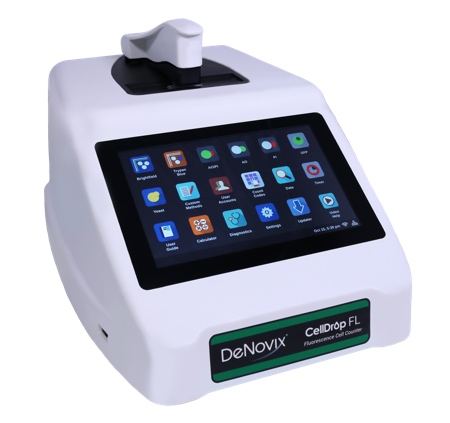Conventional cell counting techniques are limited by human error and subjectivity, which makes it difficult to achieve a true measure of viability using a hemocytometer and manual microscope. Automated systems surpass manual cell counters in terms of both throughput and precision, yet it is important to follow a simple set of best practices to guarantee the highest levels of data quality in the long-term.
The CellDrop™ series is an innovative line of automated cell counters operating on patented DirectPipette™ Technology with user-friendly analysis software, facilitating the fastest high-precision cell counting for overall count and viability assessments. In this post, DeNovix offers tips for guaranteeing cell counting accuracy with your CellDrop instrument.
Clean the Sample Surface
Contaminants on a hemocytometer or microscope slide can lead to inaccurate cell counting results – and the same is true of the CellDrop. Clean the optical-grade sapphire surfaces of the counting chamber with a dry laboratory wipe after every use for best practice. Additional cleaning may be required periodically. For a deeper clean, pipette a 15 µL solution of either 70% ethanol or 10% bleach into the cell counting chamber and let it sit for approximately 10 seconds before wiping clean.
Vortex Prior to Loading
To guarantee that an assayed sample is truly representative, vortex the solution immediately before loading into the CellDrop counting chamber. This ensures sample homogeneity, and that cell counting results accurately reflect the cell culture from which the sample is taken.
Minimize Cell Clumping
Clumping is commonly caused by extracellular DNA and cell debris within the sample, which typically arise from cell lysis. Although the CellDrop can algorithmically account for clumps in samples, the software cannot correct non-representative samples. Minimize cell clumping by avoiding factors involved in cell lysis e.g. overgrowth, mechanical shearing, freeze/thaw cycles.
Optimize Settings
Cell counting requires the best possible image capture for the most accurate results. Individually optimize each measurement channel to ensure that – when using brightfield – cells have a bright center with a distinct dark outer ring, with a sharp contrast between the cell membrane and the background. For fluorescence channels, adjust the exposure so that cells fluoresce brightly while ensuring that no light extends beyond the true size of the cell.
Use the Correct Chamber Height
The cell counting chamber of the CellDrop uses two parallel surfaces to hold samples via surface tension. Adjusting the chamber height allows for the broadest possible range of cell densities and sizes for the highest possible precision. This chamber height can be software adjusted, with on-screen guidance for users to guarantee accurate automatic adjustments.
Adjust Cell Counting Parameters
The CellDrop has a suite of applications and parameters to ensure that test conditions are optimal for the cells under study. A range of standard protocols deliver optimal results for many applications, however, the ability to fine-tune size, roundness and threshold values offer the flexibility to optimize parameters for a wide range of applications.
DeNovix: CellDrop Cell Counter Suppliers
DeNovix specializes in the design and supply of innovative analytical solutions for cell counting applications. The CellDrop is available with dual fluorescence and brightfield optics for cell counting and viability in routine cell culture and complex samples, for example, in Peripheral Blood Mononuclear Cell Counting.
If you would like to learn more about cell counting with the CellDrop, simply contact a member of the DeNovix team today.





